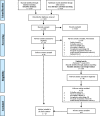The gut microbiota profile of adults with kidney disease and kidney stones: a systematic review of the literature
- PMID: 32503496
- PMCID: PMC7275316
- DOI: 10.1186/s12882-020-01805-w
The gut microbiota profile of adults with kidney disease and kidney stones: a systematic review of the literature
Abstract
Background: There is mounting evidence that individuals with kidney disease and kidney stones have an abnormal gut microbiota composition. No studies to date have summarised the evidence to categorise how the gut microbiota profile of these individuals may differ from controls. Synthesis of this evidence is essential to inform future clinical trials. This systematic review aims to characterise differences of the gut microbial community in adults with kidney disease and kidney stones, as well as to describe the functional capacity of the gut microbiota and reporting of diet as a confounder in these studies.
Methods: Included studies were those that investigated the gut microbial community in adults with kidney disease or kidney stones and compared this to the profile of controls. Six scientific databases (CINHAL, Medline, PubMed, Scopus, Web of Science and Cochrane Library), as well as selected grey literature sources, were searched. Quality assessment was undertaken independently by three authors. The system of evidence level criteria was employed to quantitatively evaluate the alteration of microbiota by strictly considering the number, methodological quality and consistency of the findings. Additional findings relating to altered functions of the gut microbiota, dietary intakes and dietary methodologies used were qualitatively summarised.
Results: Twenty-five articles met the eligibility criteria and included data from a total of 892 adults with kidney disease or kidney stones and 1400 controls. Compared to controls, adults with kidney disease had increased abundances of several microbes including Enterobacteriaceae, Streptococcaceae, Streptococcus and decreased abundances of Prevotellaceae, Prevotella, Prevotella 9 and Roseburia among other taxa. Adults with kidney stones also had an altered microbial composition with variations to Bacteroides, Lachnospiraceae NK4A136 group, Ruminiclostridium 5 group, Dorea, Enterobacter, Christensenellaceae and its genus Christensenellaceae R7 group. Differences in the functional potential of the microbial community between controls and adults with kidney disease or kidney stones were also identified. Only three of the 25 articles presented dietary data, and of these studies, only two used a valid dietary assessment method.
Conclusions: The gut microbiota profile of adults with kidney disease and kidney stones differs from controls. Future study designs should include adequate reporting of important confounders such as dietary intake to assist with interpretation of findings.
Keywords: Diet therapy; Gastrointestinal microbiome; Kidney diseases; Nephrolithiasis; Systematic review.
Conflict of interest statement
The authors declare that they have no competing interests.
Figures




References
-
- Wang B, Yao M, Lv L, Ling Z, Li L. The human microbiota in health and disease. Engineering. 2017;3:71–82.
-
- Fraher MH, O'Toole PW, Quigley E. Techniques used to characterize the gut microbiota: A guide for the clinician. 2012. pp. 312–322. - PubMed
Publication types
MeSH terms
LinkOut - more resources
Full Text Sources
Medical
Miscellaneous

